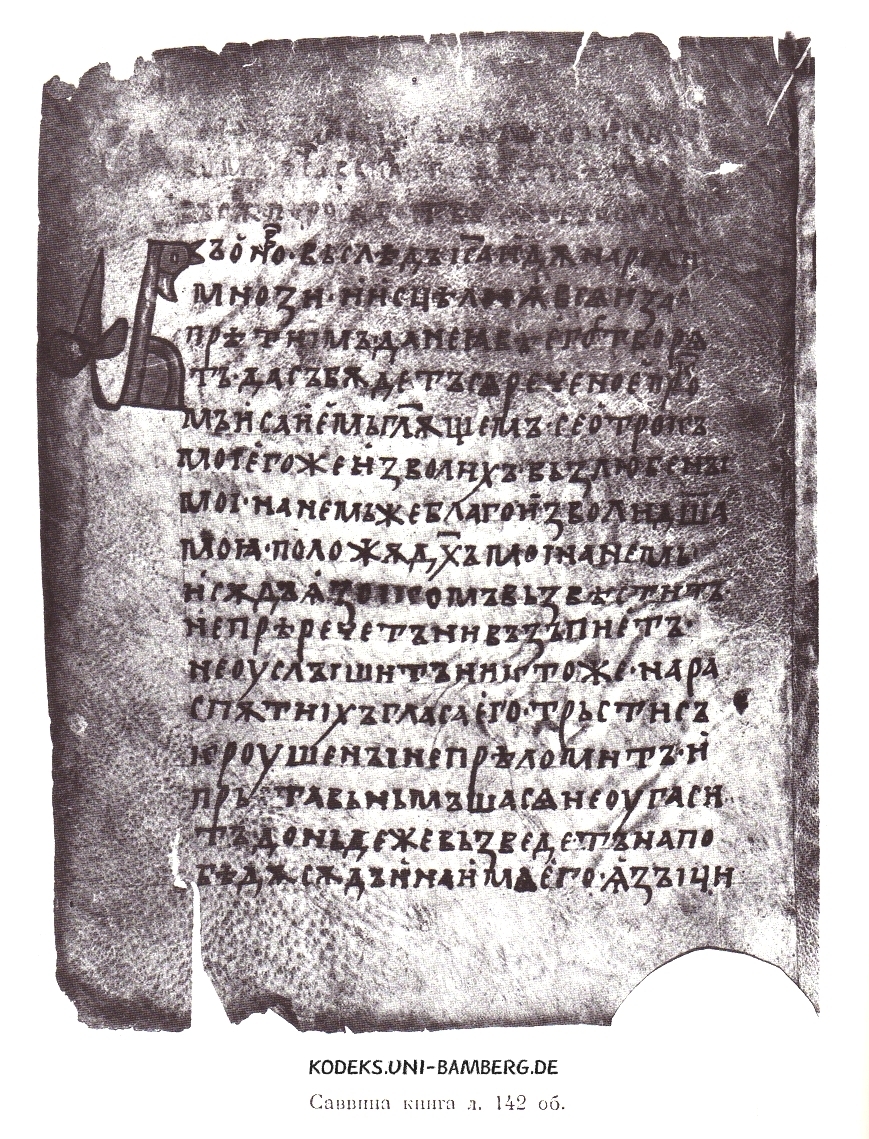Sava's book on:
[Wikipedia]
[Google]
[Amazon]
 Sava's book ( bg, Савина книга, ''Savina kniga''; russian: Саввина книга, ''Savvina kniga'') is a 129-folio Cyrillic Old Church Slavonic
Sava's book ( bg, Савина книга, ''Savina kniga''; russian: Саввина книга, ''Savvina kniga'') is a 129-folio Cyrillic Old Church Slavonic
Scans of the 1903 Ščepkin's edition
Facsimile of the manuscript
(РГАДА) Sinaiticum Old Church Slavonic canon 11th-century biblical manuscripts Medieval Bulgarian literature Cyrillo-Methodian studies Church Slavonic manuscripts
 Sava's book ( bg, Савина книга, ''Savina kniga''; russian: Саввина книга, ''Savvina kniga'') is a 129-folio Cyrillic Old Church Slavonic
Sava's book ( bg, Савина книга, ''Savina kniga''; russian: Саввина книга, ''Savvina kniga'') is a 129-folio Cyrillic Old Church Slavonic canon
Canon or Canons may refer to:
Arts and entertainment
* Canon (fiction), the conceptual material accepted as official in a fictional universe by its fan base
* Literary canon, an accepted body of works considered as high culture
** Western ca ...
evangeliary
The Evangeliary or Book of the Gospels is a liturgical book containing only those portions of the four gospels which are read during Mass or in other public offices of the Church. The corresponding terms in Latin are and .
The Evangeliary develo ...
, written in the eleventh century.
The original 126 parchment
Parchment is a writing material made from specially prepared untanned skins of animals—primarily sheep, calves, and goats. It has been used as a writing medium for over two millennia. Vellum is a finer quality parchment made from the skins o ...
folios are of Bulgarian provenance, being bound into a larger codex with later additions of the Russian Church Slavonic recension. The codex is named the priest Sav(v)a, who inscribed his name on two of the original folios. There is no other historical record of Sava, and it is therefore believed that he was one of the manuscript's copyists.
The early history of Sava's book is unknown. What can be ascertained is that the codex was in the Seredkino monastery near Pskov until at least the 17th century. Afterwards it was moved to the manuscript collection of the Moscow Synodal Printing House, where it was found in 1866 by the Russian Slavist Izmail Sreznevsky, who gave the codex its modern-day appellation and was the first one to publish it (Saint Petersburg, 1868). Today it is kept in the Central State Archive of Old Documents (CGADA) in Moscow.
The first critical edition of the manuscript was published by V. N. Ščepkin (''Savvina kniga'', Saint Petersburg 1903), photographically reprinted in Graz in 1959. Ščepkin was the first to perform a paleolinguistic analysis of the manuscript (''Razsuždenie o jazyke Savvinoj knigy'', 1899), and he ascertained that it was copied from a Glagolitic
The Glagolitic script (, , ''glagolitsa'') is the oldest known Slavic alphabet. It is generally agreed to have been created in the 9th century by Saint Cyril, a monk from Thessalonica. He and his brother Saint Methodius were sent by the Byzan ...
original. His 1903 edition led N. Karinski to propound several new readings and to fix some wrong solutions (''Perečenь važnejših netočnostei poslednego izdanija Savvinoj knigi'', Izv., XIX, 3, 206-216). Paleographic and linguistic analysis shows that the copyist wrote yers where he did not pronounce them anymore, and that behind ''č'', ''ž'' and ''š'' he wrote ''ъ'' instead of ''ь'', which indicates that the aforementioned consonants were pronounced "hard" in the scribe's mother tongue, or, more likely, that other than the preserved softness in the preceding consonant the two years had merged. There is abundant evidence for the loss of epenthetic ''l'', and, instead of iotified a
Iotated A () is a letter of the Cyrillic script, used today only in Church Slavonic. It is unusual among early Cyrillic letters in having no direct counterpart in Glagolitic: Ⱑ ( jat’) is used for both /ě/ and /ja/. Accordingly, many early ...
(), yat
Yat or jat (Ѣ ѣ; italics: ) is the thirty-second letter of the old Cyrillic alphabet and the Rusyn alphabet.
There is also another version of yat, the iotified yat (majuscule: , minuscule: ), which is a Cyrillic character combining a ...
() is often written.
See also
* Codex Zographensis * Psalterium Sinaiticum * Codex Marianus * Glagolita ClozianusReferences
* * {{cite book, last= Schenker, first= Alexander , author-link=Alexander M. Schenker , title=The Dawn of Slavic: An Introduction to Slavic Philology , publisher=Yale University Press , location= New Haven , year= 1995 , isbn=0-300-05846-2External links
Scans of the 1903 Ščepkin's edition
Facsimile of the manuscript
(РГАДА) Sinaiticum Old Church Slavonic canon 11th-century biblical manuscripts Medieval Bulgarian literature Cyrillo-Methodian studies Church Slavonic manuscripts